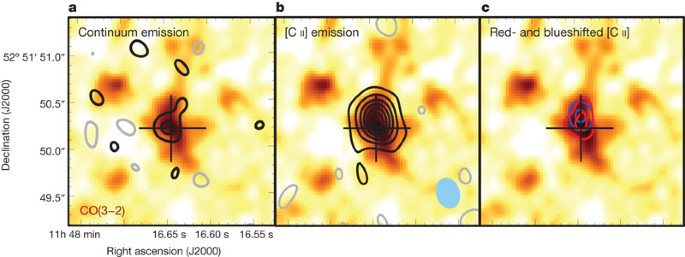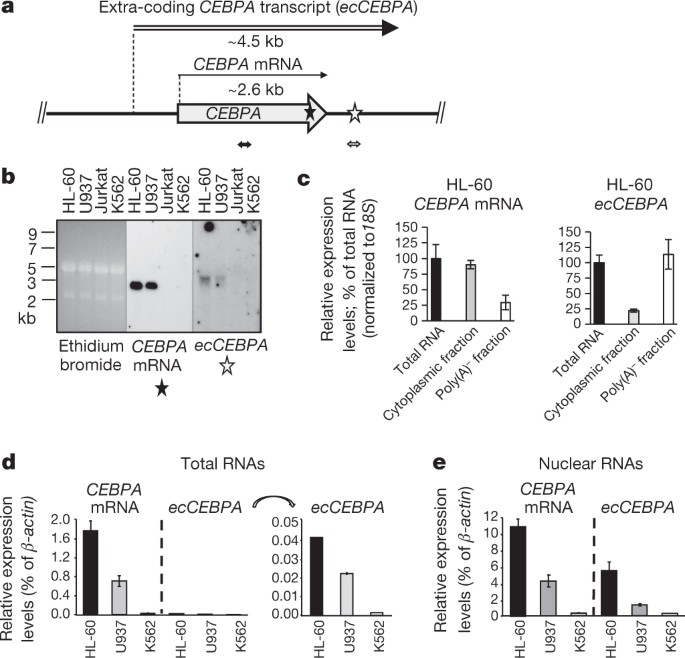
- Select a language for the TTS:
- UK English Female
- UK English Male
- US English Female
- US English Male
- Australian Female
- Australian Male
- Language selected: (auto detect) - EN
Play all audios:
ABSTRACT The host galaxy of the quasar SDSS J114816.64+525150.3 (at redshift _z_ = 6.42, when the Universe was less than a billion years old) has an infrared luminosity of 2.2 × 1013 times
that of the Sun1,2, presumably significantly powered by a massive burst of star formation3,4,5,6. In local examples of extremely luminous galaxies, such as Arp 220, the burst of star
formation is concentrated in a relatively small central region of <100 pc radius7,8. It is not known on which scales stars are forming in active galaxies in the early Universe, at a time
when they are probably undergoing their initial burst of star formation. We do know that at some early time, structures comparable to the spheroidal bulge of the Milky Way must have formed.
Here we report a spatially resolved image of [C ii] emission of the host galaxy of J114816.64+525150.3 that demonstrates that its star-forming gas is distributed over a radius of about 750
pc around the centre. The surface density of the star formation rate averaged over this region is ∼1,000 year-1 kpc-2. This surface density is comparable to the peak in Arp 220, although
about two orders of magnitude larger in area. This vigorous star-forming event is likely to give rise to a massive spheroidal component in this system. Access through your institution Buy or
subscribe This is a preview of subscription content, access via your institution ACCESS OPTIONS Access through your institution Subscribe to this journal Receive 51 print issues and online
access $199.00 per year only $3.90 per issue Learn more Buy this article * Purchase on SpringerLink * Instant access to full article PDF Buy now Prices may be subject to local taxes which
are calculated during checkout ADDITIONAL ACCESS OPTIONS: * Log in * Learn about institutional subscriptions * Read our FAQs * Contact customer support SIMILAR CONTENT BEING VIEWED BY OTHERS
A DUSTY COMPACT OBJECT BRIDGING GALAXIES AND QUASARS AT COSMIC DAWN Article 13 April 2022 A MATURE QUASAR AT COSMIC DAWN REVEALED BY JWST REST-FRAME INFRARED SPECTROSCOPY Article 17 June
2024 DETECTION OF STELLAR LIGHT FROM QUASAR HOST GALAXIES AT REDSHIFTS ABOVE 6 Article 28 June 2023 REFERENCES * Bertoldi, F. et al. Dust and molecular emission from high-redshift quasars.
_Astron. Astrophys._ 406, 55–58 (2003) Article ADS Google Scholar * Beelen, A. et al. 350 micron dust emission from high-redshift quasars. _Astrophys. J._ 642, 694–701 (2006) Article ADS
CAS Google Scholar * Walter, F. et al. Molecular gas in the host galaxy of a quasar at redshift _z_ = 6.42. _Nature_ 424, 406–408 (2003) Article ADS CAS Google Scholar * Bertoldi, F.
et al. High-excitation CO in a quasar host galaxy at _z_ = 6.42. _Astron. Astrophys. Lett._ 409, 47–50 (2003) Article ADS Google Scholar * Maiolino, R. et al. First detection of [C ii]
158 µm at high redshift: vigorous star formation in the early universe. _Astron. Astrophys. Lett._ 440, 51–54 (2005) Article ADS Google Scholar * Carilli, C. et al. Radio continuum
imaging of far-infrared-luminous QSOs at _z_ > 6. _Astron. J._ 128, 997–1001 (2004) Article ADS CAS Google Scholar * Downes, D. & Solomon, P. Rotating nuclear rings and
extreme starbursts in ultraluminous galaxies. _Astrophys. J._ 507, 615–654 (1999) Article ADS Google Scholar * Scoville, N. Z., Yun, M. S. & Bryant, P. M. Arcsecond imaging of CO
emission in the nucleus of Arp 220. _Astrophys. J._ 484, 702–719 (1997) Article ADS CAS Google Scholar * Tielens, A. G. G. M. & Hollenbach, D. Photodissociation regions. I. Basic
model. II. A model for the Orion photodissociation region. _Astrophys. J._ 291, 722–754 (1985) Article ADS CAS Google Scholar * Stacey, G. J. et al. The 158 micron forbidden C ii line—a
measure of global star formation activity in galaxies. _Astrophys. J._ 373, 423–444 (1991) Article ADS CAS Google Scholar * Fan, X. et al. A survey of _z_ > 5.7 quasars in the
Sloan Digital Sky Survey. II. Discovery of three additional quasars at _z_ > 6. _Astron. J._ 125, 1649–1659 (2003) Article ADS Google Scholar * Fan, X. et al. Constraining the
evolution of the ionizing background and the epoch of reionization with _z_ ∼ 6 quasars. II. A sample of 19 quasars. _Astron. J._ 132, 117–136 (2006) Article ADS CAS Google Scholar *
Iono, D. et al. A detection of [C ii] line emission in the _z_ = 4.7 QSO BR 1202–0725. _Astrophys. J. Lett._ 645, 97–100 (2006) Article ADS Google Scholar * Walter, F. et al. Resolved
molecular gas in a quasar host galaxy at redshift z = 6.42. _Astrophys. J. Lett._ 615, 17–20 (2004) Article ADS Google Scholar * Spergel, D. N. et al. Three-year Wilkinson Microwave
Anisotropy Probe (WMAP) observations: Implications for cosmology. _Astrophys. J._ 170 (Suppl.). 377–408 (2007) Article Google Scholar * Wright, E. L. A cosmology calculator for the World
Wide Web. _Publ. Astron. Soc. Pacif._ 118, 1711–1715 (2006) Article ADS Google Scholar * Riechers, D. A., Walter, F., Carilli, C. & Bertoldi, F. observations of dense molecular gas in
a quasar host galaxy at z = 6.42: Further evidence for a nonlinear dense gas–star formation relation at early cosmic times. _Astrophys. J. Lett._ 671, 13–16 (2007) Article ADS Google
Scholar * Omont, A. et al. A 1.2 mm MAMBO/IRAM-30 m survey of dust emission from the highest redshift PSS quasars. _Astron. Astrophys._ 374, 371–381 (2001) Article ADS Google Scholar *
Werner, M. W. et al. One arc-minute resolution maps of the Orion Nebula at 20, 50, and 100 microns. _Astrophys. J._ 204, 420–426 (1976) Article ADS CAS Google Scholar * Tacconi, L. et
al. High-resolution millimeter imaging of submillimeter galaxies. _Astrophys. J._ 640, 228–240 (2006) Article ADS CAS Google Scholar * Thompson, T., Quataert, E. & Murrey, N.
Radiation pressure-supported starburst disks and active galactic nucleus fueling. _Astrophys. J._ 630, 167–185 (2005) Article ADS Google Scholar * Elmegreen, B. G. Galactic bulge
formation as a maximum intensity starburst. _Astrophys. J._ 517, 103–107 (1999) Article ADS Google Scholar * Gao, Y. & Solomon, P. M. HCN survey of normal spiral, infrared–luminous,
and ultraluminous galaxies. _Astrophys. J._ 152 (Suppl.). 63–80 (2004) Article ADS CAS Google Scholar * Dekel, A. et al. Cold streams in early massive hot haloes as the main mode of
galaxy formation. _Nature_ 10.1038/nature07648 (in the press) * Walter, F. & Carilli, C. Detecting the most distant (_z_ > 7) objects with ALMA. _Astrophys. Space Sci._ 313,
313–316 (2008) Article ADS CAS Google Scholar * White, R. L., Becker, R. H., Fan, X. & Strauss, M. A. Hubble Space Telescope Advanced Camera for Surveys observations of the _z_ =
6.42 quasar SDSS J1148+5251: A leak in the Gunn–Peterson trough. _Astron. J._ 129, 2102–2107 (2005) Article ADS CAS Google Scholar * Solomon, P. M. & Vanden Bout, P. A. Molecular gas
at high redshift. _Annu. Rev. Astron. Astrophys._ 43, 677–725 (2005) Article ADS CAS Google Scholar * Malhotra, S. et al. Infrared Space Observatory measurements of [C ii] line
variations in galaxies. _Astrophys. J._ 491, 27–30 (1997) Article ADS Google Scholar * Luhman, M. L. et al. Infrared Space Observatory measurements of a [C ii] 158 micron line deficit in
ultraluminous infrared galaxies. _Astrophys. J. Lett._ 504, 11–15 (1998) Article ADS Google Scholar Download references ACKNOWLEDGEMENTS This work is based on observations carried out
with the IRAM Plateau de Bure Interferometer. IRAM is supported by MPG (Germany), INSU/CNRS (France) and IGN (Spain). D.R. acknowledges support from NASA through a Hubble Fellowship awarded
by the Space Telescope Science Institute, which is operated by the Association of Universities for Research in Astronomy, Inc., for NASA. C.C. acknowledges support from the Max-Planck
Gesellschaft and the Alexander von Humboldt Stiftung through the Max-Planck-Forschungspreis 2005. F.W. and D.R. appreciate the hospitality of the Aspen Center for Physics, where this
manuscript was written. AUTHOR INFORMATION AUTHORS AND AFFILIATIONS * Max-Planck-Institut für Astronomie, Königstuhl 17, D-69117 Heidelberg, Germany , Fabian Walter & Dominik Riechers *
California Institute of Technology, 1200 East California Boulevard, Pasadena, California 91125, USA , Dominik Riechers * Institut de Radio Astronomie Millimétrique, 300 rue de la Piscine,
F-38406 St-Martin-d’Hères, France , Pierre Cox & Roberto Neri * National Radio Astronomy Observatory, PO Box O, Socorro, New Mexico 87801, USA , Chris Carilli * Argelander Institut für
Astronomie, Auf dem Hügel 71, D-53121 Bonn, Germany , Frank Bertoldi * Max-Planck-Institut für Radioastronomie, Auf dem Hügel 69, D-53121 Bonn, Germany , Axel Weiss * L’Istituto Nazionale di
Astrofisica, Osservatorio Astronomico di Roma, I-00040 Monte Porzio Catone, Roma, Italy , Roberto Maiolino Authors * Fabian Walter View author publications You can also search for this
author inPubMed Google Scholar * Dominik Riechers View author publications You can also search for this author inPubMed Google Scholar * Pierre Cox View author publications You can also
search for this author inPubMed Google Scholar * Roberto Neri View author publications You can also search for this author inPubMed Google Scholar * Chris Carilli View author publications
You can also search for this author inPubMed Google Scholar * Frank Bertoldi View author publications You can also search for this author inPubMed Google Scholar * Axel Weiss View author
publications You can also search for this author inPubMed Google Scholar * Roberto Maiolino View author publications You can also search for this author inPubMed Google Scholar CORRESPONDING
AUTHOR Correspondence to Fabian Walter. POWERPOINT SLIDES POWERPOINT SLIDE FOR FIG. 1 POWERPOINT SLIDE FOR FIG. 2 RIGHTS AND PERMISSIONS Reprints and permissions ABOUT THIS ARTICLE CITE
THIS ARTICLE Walter, F., Riechers, D., Cox, P. _et al._ A kiloparsec-scale hyper-starburst in a quasar host less than 1 gigayear after the Big Bang. _Nature_ 457, 699–701 (2009).
https://doi.org/10.1038/nature07681 Download citation * Received: 25 July 2008 * Accepted: 18 November 2008 * Issue Date: 05 February 2009 * DOI: https://doi.org/10.1038/nature07681 SHARE
THIS ARTICLE Anyone you share the following link with will be able to read this content: Get shareable link Sorry, a shareable link is not currently available for this article. Copy to
clipboard Provided by the Springer Nature SharedIt content-sharing initiative





